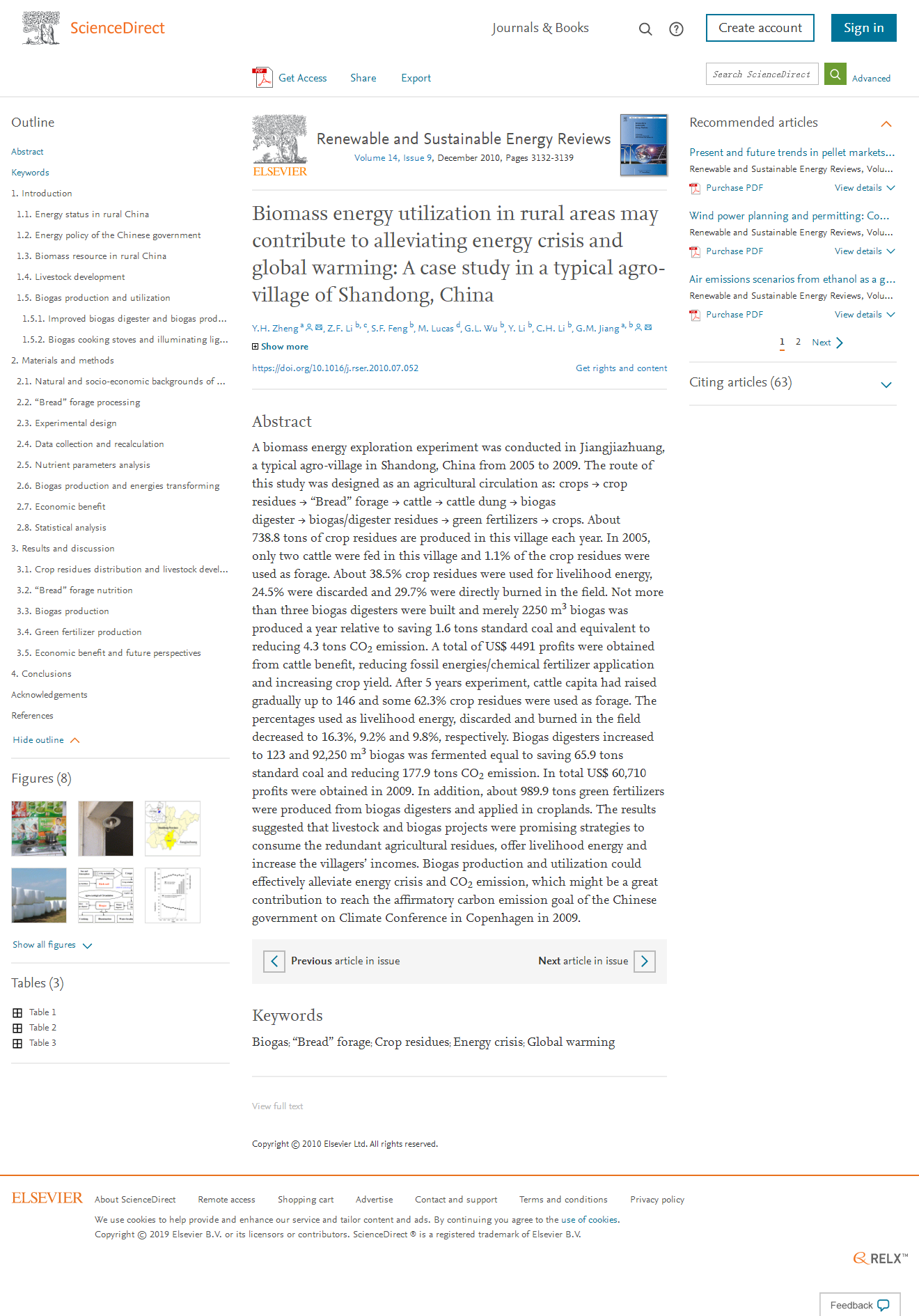博文
农村生物质能利用有助于缓解能源危机与全球变暖:以山东省某典型农村为例
|||
农村生物质能利用有助于缓解能源危机与全球变暖:以山东省某典型农村为例
郑延海1、李宗奉2、冯素飞2、卢卡斯3、吴光磊1、李勇1、李彩虹1、蒋高明1*
(1中国科学院植物研究所植被与环境变化重点实验室,2山东农业大学学农学院,3德国亚申大学)
*通讯作者
文章出处:《可更新可持续能源评述》, 第14卷第3132-3139页 (影响因子:11.239)
2005-2009年,在山东省典型农村蒋家庄进行了生物质能利用探索试验。本研究设计路径为:作物→作物残体→“面包草”饲料→牛→牛粪→沼气池→沼气/沼渣沼液→绿色肥料→作物之农业循环。蒋家庄每年产生农作物秸秆约738.8吨。2005年,该村仅饲养2头牛;1.1%秸秆用作饲料,约38.5%秸秆被用作生活能源,24.5%被丢弃,29.7%在田间被直接焚烧;沼气池3座,年沼气产量仅2250立方米;相对节约标准煤1.6吨,减少二氧化碳排放4.3吨;当年通过养牛、减少化石能源/化肥施用和提高作物产量等方面共获得4491美元利润。经过5年试验,牛饲养量逐渐提高到146头,62.3%秸秆被用作饲料,而作为生活能源、废弃和地头焚烧比例分别下降到16.3%、9.2%和9.8%;沼气池数量增加到123座,产生沼气92250立方米,相当于标准煤65.9吨,减少二氧化碳排放177.9吨;2009年共获得利润60710美元。此外,沼气池生产绿色肥料989.9吨左右,可用于农田施肥替代部分化肥。结果表明,畜牧业和沼气工程是解决农村剩余物消耗、提供生活能源和增加村民收入的有效途径。沼气生产和利用可有效缓解能源危机和二氧化碳排放。该实验对实现2009年哥本哈根中国政府气候大会确定的碳排放目标具有重要借鉴意义。
关键词:沼气 “面包草”饲料 作物秸秆 能源危机 全球变暖
Biomass energy utilization in rural areas may contribute to alleviating energy crisis and global warming: A case study in a typical agro-village of Shandong, China
Zheng Y.H., Li Z.F., Feng S.F., Lucas M., Wu G.L., Li Y., Li C.H. & Jing G.M* 2010
Renewable and Sustainable Energy Reviews, 14:3132-3139. (IF=11.239)
A biomass energy exploration experiment was conducted in Jiangjiazhuang, a typical agro-village in Shandong, China from 2005 to 2009. The route of this study was designed as an agricultural circulation as: crops → crop residues → “Bread” forage → cattle → cattle dung → biogas digester → biogas/digester residues → green fertilizers → crops. About 738.8 tons of crop residues are produced in this village each year. In 2005, only two cattle were fed in this village and 1.1% of the crop residues were used as forage. About 38.5% crop residues were used for livelihood energy, 24.5% were discarded and 29.7% were directly burned in the field. Not more than three biogas digesters were built and merely 2250 m3 biogas was produced a year relative to saving 1.6 tons standard coal and equivalent to reducing 4.3 tons CO2 emission. A total of US$ 4491 profits were obtained from cattle benefit, reducing fossil energies/chemical fertilizer application and increasing crop yield. After 5 years experiment, cattle capita had raised gradually up to 146 and some 62.3% crop residues were used as forage. The percentages used as livelihood energy, discarded and burned in the field decreased to 16.3%, 9.2% and 9.8%, respectively. Biogas digesters increased to 123 and 92,250 m3 biogas was fermented equal to saving 65.9 tons standard coal and reducing 177.9 tons CO2 emission. In total US$ 60,710 profits were obtained in 2009. In addition, about 989.9 tons green fertilizers were produced from biogas digesters and applied in croplands. The results suggested that livestock and biogas projects were promising strategies to consume the redundant agricultural residues, offer livelihood energy and increase the villagers’ incomes. Biogas production and utilization could effectively alleviate energy crisis and CO2 emission, which might be a great contribution to reach the affirmatory carbon emission goal of the Chinese government on Climate Conference in Copenhagen in 2009.
Keywords: Biogas “Bread” forage Crop residues Energy crisis Global warming

https://wap.sciencenet.cn/blog-475-1204737.html
上一篇:厌氧发酵提高了生物质能在农作物秸秆利用和沼气生产中的利用效率
下一篇:使用太阳能捕虫灯可大幅度减少杀虫剂用量:以冬小麦夏玉米轮作系统为例